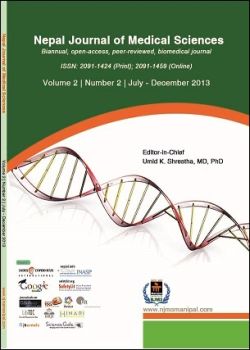Down Syndrome and Congenital Heart Disease: Single centre, Prospective Study
DOI:
https://doi.org/10.3126/njms.v2i2.8944Keywords:
Congenital heart disease, down syndrome, pulmonary hypertensionAbstract
Background: The objective of this study was to evaluate the children with down syndrome regarding the frequency and types of congenital heart disease and associated pulmonary hypertension.
Method: A prospective study was carried out to all the children with down syndrome visited in pediatric outpatient department over the period of one year. Necessary data were recorded in preformed format.
Results: Fifty children with down syndrome were evaluated. Forty (80%) had an associated congenital heart disease. The median age at diagnosis was 2 years (range = 4 days to 12 years). In 26 patients (65%), the cardiac lesion was isolated, while 14 patients (35%) had multiple defects. The most common single defect was ventricular septal defect (VSD), found in 9 of the 40 patients (22.5%), followed by atrioventricular septal defect (AVSD) in 15%, atrial septal defect (ASD) and patent ductus arteriosus (PDA) each in 10%. The most frequent concomitant malformation found co-existing with other congenital cardiac lesions was PDA (15%). Pulmonary hypertension was found in 21 of 40 patients (52.5%) and AVSD was most frequently associated with pulmonary hypertension.
Conclusion: Congenital heart disease is very common in patient with down syndrome. VSD is the most common cardiac defect and AVSD is second to VSD. Patient with down syndrome with CHD frequently develop pulmonary hypertension at younger age hence early cardiac screening by echocardiography in these patients is crucial. Early diagnosis and management is the key to avoid irreversible hemodynamic consequences of the defect.
Nepal Journal of Medical Sciences | Volume 02 | Number 02 | July-December 2013 | Page 96-101
Downloads
Downloads
Published
How to Cite
Issue
Section
License
Copyright © by Nepal Journal of Medical Sciences. The ideas and opinions expressed by authors of articles summarized, quoted, or published in full text in this Journal represents only opinions of authors and do not necessarily reflect the official policy of Nepal Journal of Medical Sciences or the institute with which the author(s) is (are) affiliated, unless so specified.




